Live from London: Fox Sports and ESPN combine with NEP as MLB comes to the UK
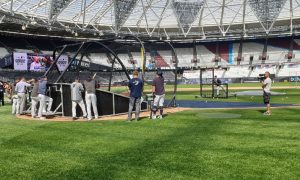
MLB team the New York Yankees go for some batting practice at the purpose-built pitch in the London Stadium
Major League Baseball (MLB) arrived in the UK for the first time last weekend (June 29-30), complete with a custom-built pitch at the London Stadium in Stratford and an entirely new language of broadcasting plus some unusual technology in play, for the Brits at least.
The New York Yankees and Boston Red Sox arrived in London to show people on this side of the pond what the game of baseball is really about, bringing the two clubs’ ongoing rivalry with them. Despite the Red Sox laying claim to the 2018 World Series, the Yankees, the highest funded US baseball team, won both games.
Broadcasting the event also included a bunch of firsts, with baseball never having been covered at this level before in Europe. The challenges faced by ESPN, Fox Sports and technical partner NEP in producing the broadcasting for this event were many, from working with a newly reconfigured venue to host an MLB baseball event, to camera positions, cable infrastructure, connectivity, formats, and conversions, as well as ESPN’s graphics remote integration (Gremi) workflow and all the terminology that goes with baseball.
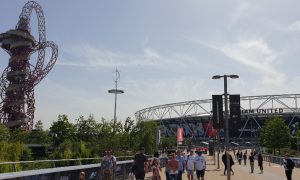
The London Stadium in Stratford ready for the Yankees and Red Sox to duke it out
A unique event in the UK
MLB has been working closely with Fox Sports and ESPN to bring baseball to the UK. Speaking to SVG Europe, Jim Small, MLB senior vice president, international, said: “The broadcast has been quite a challenge. This is a unique event because there has never been baseball played here before. The easy part is where to park your truck; everything else here is hard!”
Judy Acone, director, international broadcast operations for MLB Network, has been key in the process of bringing this broadcast and weekend of baseball to the UK. She has been involved in all the meetings with European broadcasters over the past year in preparation for this event, helping them understand how to cover baseball.
Added Small: “This has really been a collaborative effort. We have a vested interest in making sure Fox and ESPN get everything they need and Judy has worked hard to achieve that.”
Acone noted: “This is two cultures coming together, and to make that work we have the A-teams from both Fox Sports and ESPN.”
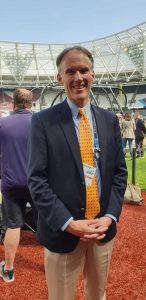
Major League Baseball’s Jim Small, senior vice president, international
Americans sharing resources
For the first time ever, Fox Sports and ESPN have shared all resources for the broadcast, from kit to people. However, Fox Sports took the feed on Saturday and ESPN on Sunday, with each also producing a pre-game 30 minute show and one hour show respectively. On the Friday, both broadcasters also filmed batting practice and created highlight shows for their US viewers.
Commented Brad Cheney, vice president of field operations and engineering at Fox Sports: “Everything we’re doing here is a full share with ESPN. This is the first time we’ve done this [to this degree]; normally everything is separate.”
Last year in Puerto Rico Fox Sports did the same but to a slightly lesser degree with ESPN. Cheney noted that this effort was “far more streamlined” as Puerto Ricans are obsessed with baseball. Said Cheney: “They do baseball [in Puerto Rico]. They have stadiums and people that understand the sport. Here [in the UK] we’ve had to bring more people and kit over, and build a pitch. The inside of the stadium went better than we could have hoped, although we had to build camera towers because the camera positions are different in baseball than they are in football. We even have an entire production truck dedicated just to the scoreboard; in a purpose-built stadium there would be a control room built in for that purpose.”
Said Kevin Cleary, audio specialist at ESPN: “As far as I’m aware this is the first time two American networks have ever put all their resources into one control room.”

Brad Cheney, vice president of field operations and engineering at Fox Sports
Noted Paul Horrell, remote operations manager at ESPN: “It’s a lot to plan for in considering all needs, but we are fortunate that we have a great supplier [NEP] and broadcast partners that couldn’t be easier to work with to make this all happen. Early on in our discussions, it was immediately apparent that with Fox Sports having the game on the 29 May and ESPN having the game on the 30 May, we could repeat our shared approach for equipment and resources as we did last year in Puerto Rico, and maximise overall production value for all games.
“We’ve taken an unprecedented shared approach to these London games, using the same mobile units and equipment, a ‘hybrid’ crew comprised of Fox Sports and ESPN operators, and Gremi Bristol [US]-based EVS operators being used for both the Fox Sports and ESPN games,” Horrell went on.
Fox Sports and ESPN acted as the host broadcasters for the event. BT Sport took the feed while also using some of its own cameras on site; BBC Digital had its own advertising-free feed; while BeIN in France used its own French announcers commentating over the Fox Sports and ESPN feeds on site.
Learning curve for NEP
NEP provided everything end to end for this broadcast, from the trucks to robotic cameras (Fletcher) and connectivity (NEP Connect). The challenge in bringing the broadcast together has involved a lot of time, learning and adaption, which NEP has taken on board to help further its long standing relationship with ESPN and Fox Sports on this side of the pond.
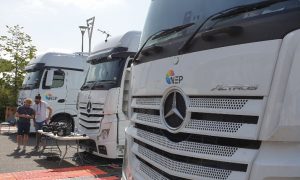
NEP had to highly customise three trucks for the MLB London Series
The glue pulling the broadcasting operation together is, everyone agreed, NEP US’ Nick Romano, engineering manager for NEP US mobile units, who is both Fox Sports’ and ESPN’s lead engineer for Fox Sports on the World Series, and ESPN on its Sunday Night Baseball programme. “Honestly, without him, this doesn’t happen,” Cheney said emphatically.
Romano was able to interpret the game of baseball from a broadcasting perspective to NEP and the broadcasters taking Fox Sports’ and ESPN’s feeds from this showcase. When MLB decided to hold this showcase just over one year ago, Cheney said Fox Sports and ESPN told NEP UK that Romano had to be bought over to help.
The teams from ESPN and Fox Sports came over to the UK in August 2018 for a site survey, and again in January this year to work out the final set up and finalise the technical infrastructure.
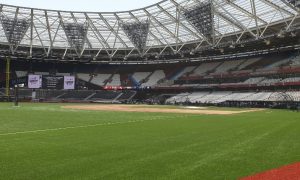
The newly built baseball pitch at the London Stadium in Stratford
Explained Cheney: “We said at our first meeting with Brian that we need Nick, so we’re very grateful to NEP for that. [Romano] understands what we do so could interpret for NEP here. It’s not just about the difference between how we might produce TV in the US versus the UK; it’s the fact that no one here has done this sport before, which adds a whole new complexity to this set up.”
Romano has been integral to creating the broadcast for this event, agreed Brian Clark, sales director, NEP UK major projects group: “We’re lucky NEP is an American company. Romano has helped us out with transmission paths, EVS, and even broadcast specific terms used in baseball for things like camera positions, such as ‘down the line’; when a director comes around and says something using baseball terminology, you need to understand what he wants.”
ESPN senior remote operations producer on site, Brock Wetherbee, added: “Staff [in the UK] have had to be coached throughout the event, as the first time most of them will see a baseball game will be when they cover it. This means everything is taking a long time, even meetings, because everyone needs to be coached all the way through.”
Romano commented: “Our team in the UK is amazing but they’ve never done baseball before so this project [has been] about helping them do this. NEP as a company is global, and this is an excellent opportunity for the divisions to work together. The good thing about this is we listen and we grow, blending what we do in the States with here [in the UK and Europe].”
On listening, the major challenge has been teaching those that have not worked in the baseball field before the broadcasting requirements and terminologies of the sport. Said Romano: “We’ve been spending a lot of time communicating the game of baseball… For any European, this is like trying to explain cricket to a US crew; there are unique things.”
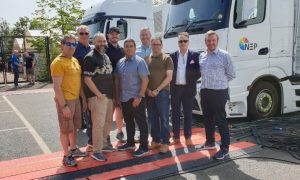
The MLB London Series team from ESPN, Fox Sports and NEP – [L to R] Sid Drexler from Fox Sports, Kevin Cleary from ESPN, Nick Romano from NEP US, Brock Weatherbee from ESPN, Francisco Contreras from Fox Sports, Brad Cheney from Fox Sports, Trevor Peters from NEP UK, Brian Clark from NEP, Mike McGaw from NEP UK
While in the US NEP has customised OB trucks specifically for baseball productions for Fox Sports and ESPN, the specifics of a baseball broadcast meant that NEP UK had to do a lot of customisation on its trucks for the showcase, making adaptations to the workflow.
Clark said: “We’ve made massive changes to the trucks. For MLB it’s a different [workflow] design, so we’ve had to adapt our trucks.”
The set up included three NEP OBs: one domestic truck sending feeds back to the US; one screens and video board truck; and one ESPN and Fox Sports support truck.

Brian Clark, sales director, NEP UK major projects group, in the sunshine at the London Stadium
Commented Horrell: “This was really a complete package provided from NEP, enlisting the UK division trucks Sargasso and Aegean with Mercury as B unit, additional equipment including many cross converters due to producing everything on site in 1080p50. Conversion was really a key factor as we had to supply many feeds for local broadcast, MLB replays, as well as convert to 720p60 for all main game transmission and Gremi multiviewer fibre paths to Bristol. You’re limited to the available bandwidth with the fibre connectivity so we had to adjust our standard Gremi template somewhat to compensate. We were able to reconfigure and fit everything into the allotted bandwidth.”
Brits and the Gremi model
ESPN is well known for its Gremi model in the US, particularly for baseball, where EVS kit on the trucks on location are controlled remotely by operators in Bristol, Connecticut, US. The broadcaster began using Gremi for productions five years ago, yet along with fibre optic networking, it has come into its own in the last two years.
Horrell commented on the use of Gremi for the London Series: “Going into this game and very early on in discussions with production, our goal was really to emulate our typical Sunday Night Baseball levels with Baseball Tonight and Deportes on site, and the associated workflows as much as possible, including our graphic and EVS remote operator integrations, our Gremi model.
“As has become standard on all of our MLB productions in the States, the Gremi model dictates a level of low latency connectivity best achieved with fibre, and given the nature of the location, we knew that might present a challenge. Our inhouse traffic and transmission folks worked with our vendor The Switch to provide the fibre solutions we needed in order to accomplish this, and it worked out great,” added Horrell.
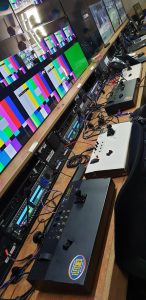
ESPN’s Gremi strations ready to be controlled by operators in Bristol, US
The London Series also marked the first time Fox Sports has used a Gremi execution model, and it is doing so in collaboration with ESPN, using ESPN’s equipment and staff.
Eric Cooney, CEO at The Switch, said that live feeds from the stadium were sent to ESPN’s remote production facility using The Switch’s point to point Ethernet solution and JPEG 2K video transport to reduce latency and ensure high video quality. “The Switch’s field engineering support team were on location to make sure the feed remained uninterrupted throughout the event and that every pitch, catch and home run was enjoyed by fans. We’ve worked with ESPN and MLB in the US for many years, so for us to support them from our London NOC is a natural progression.”
Noted Clark: “Our trucks are not built to do Gremi; we had to adapt them to be able to do that. [Fox Sports and ESPN’s trucks in the US] also do back bench cuts and different cuts for different purposes, all using the same standards, delivering 42 feeds. It’s their rolling circus.”
Cleary said: “This is also the first time these trucks have done a Gremi style production. In our EVS room here on the truck we have three operators, and we also have four EVS operators in Bristol [US] operating the EVS systems on site, remote controlled. We are sending them multiviewer paths, so they [in Bristol, US] can see it off the machine as they would see it here. And it’s the same with comms; we’ve extended that out network out too.”
Standard nightmare
The complicated part of this broadcast has been the standards difference between the UK, Europe and the US. Cheney said: “We normally film in 720p60, but here people use 1080p50. We decided to use 1080p50 because the higher quality we can do, the better it looks everywhere, and BT Sport can use it for their 4K channel.”
Clark noted that the team were transmitting in UK 1080p and 1080i (locally for BT Sport and BBC Digital among others), plus US 60Hrz standards 1080p5994, 1080i5994, and 720p5994. “All these standards need to get to the right places at the right times,” said Clark. “We are using 46 standards converters, taking the original 1080 and converting to all these different flavours. There are 22 feeds leaving this site.”
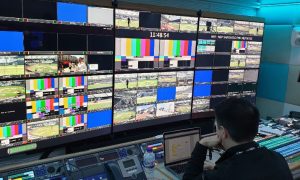
Fox Sports and ESPNs shared London Series control room on board an NEP truck
Commented Horrell: “Our goal was to emulate our standard Sunday Night Baseball broadcast levels including BBTN and Deportes, but based on the shared agreement with Fox and considering desired levels for each broadcaster, we came up with a crew and equipment level that worked equally well for both games which resulted in better coverage across the board for both broadcasters, creating a win-win scenario.”
Cameras and strike zones
While a baseball game can be covered with a minimum of four cameras, the 28 cameras used for the London Series puts last weekend’s production on a par with a World Series game of baseball. The game cameras included: 13 GV86 truck cameras; two Sony 2500 cameras (RF Held); five Sony P-1 robo’s; four Sony 4300 SSMO’s (1-6x, 3-4x); TVU cellular-based ENG; Marshall POV; and a helicopter aerial.
However, Cheney said: “Actual camera positions [for baseball] didn’t exist here. A lot of work went into working this out. We spent time with our international partners finding out what they needed, like 4K.”
Graphics vendor SMT provided its strike zone Live K-Zone software for use during the weekend. This literally draws a rectangular zone around the area in which the batter attempts to hit the ball. It shows the location of the ball within the strike zone, the speed in miles per hour of the ball at that point, and the software indicates whether that ball was a ‘strike’ (inside the box and therefore a valid ball), or a ‘ball’ (outside of the box and therefore not a valid ball).
Commented Wetherbee: “This software is great if your favourite player doesn’t hit the ball, as you can see the ball was travelling at, say, 101Mph, so you don’t feel so bad.”
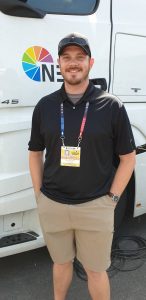
ESPN senior remote operations producer on site, Brock Wetherbee
ESPN’s proprietary software, K-Zone 3D, which it started using wholesale last year, was also in use. At this year’s annual Emmy Sports Awards, ESPN’s K-Zone 3D picked up the Wensel Technical Achievement Award. The software provides a 3D strike zone box that shows the viewer how the ball travels through the box, and a lot more.
Other innovations used for the London Series include fibre for the main transmission and a satellite uplink as backup, as well as TVU mobile-based transmission systems.
Growing the game
The MLB has already confirmed the showcase will be back in London next year, this time with the Cubs v Cardinals. On how the league is planning to grow the game, Small stated: “Our overall plan is to grow the game and engage with fans around the world. But the world is a big place so we need to target carefully.” He said the MLB has experienced success in Japan, where baseball has taken the country by storm, and Latin America. “But to grow the game we now have to focus on countries and fans where baseball does not have a presence.”
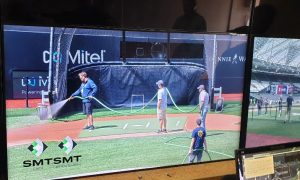
Graphics company SMT provided its strike zone Live K-Zone software for use during the weekend
On fans in the UK and on the continent, Small noted that there is already a substantial number of dedicated viewers. He added: “If you’re a fan in Europe you’re staying up till 2am [to watch matches played in the US]. You’re hardcore… We want people to look at baseball eventually as a British sport. That’s how the Japanese, Mexicans and Koreans feel about it, and that’s what we need to develop here.”
The MLB has been investing in Europe since 1990, resulting in the sport being relatively popular in European countries. For instance, one of the best players in the US league is German; Maximilian Kepler-Różycki is an outfielder for the Minnesota Twins.
Small continued that now the MLB is attempting to encourage children in the UK to play baseball. It is focusing on giving children, “social permission” to play baseball, in other words to make the sport cool enough that children are happy to take part. It has sent 50 schools in London and Birmingham a ‘baseball in a box’ kit including equipment and a manual for PE teachers to start kids off; strategically each school targeted is near an actual baseball club, so if children want to go further there is a local place to play outside of school.
